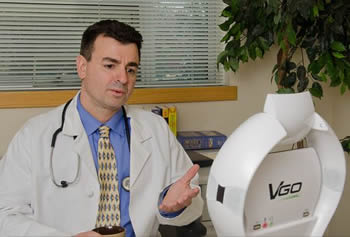Telemedicine Market is Expected to Double in Five Years
The global telemedicine market is expected to skyrocket from $11.6 billion in 2011 to $27.3 billion in 2016, according to research from BCC Research published this month. “There has been a global focus on the use of telemedicine as a tool to cut down healthcare costs and bring about mammoth savings,” the report asserted. “Implementation of the new U.S. healthcare law will, if anything, intensify this focus, by increasing the number of people with health insurance and seeking medical services. In the near to mid-term, telemedicine technologies offer one of the few ways of enabling healthcare personnel to meet the increased demand without unacceptable delays or other forms of de facto rationing.”
 At VGo, we are excited to be on the cutting edge of telemedicine, with innovative healthcare facilities like Children’s Hospital Boston and Palomar Health already using our affordable VGo telepresence robot to increase service levels. These facilities are finding that the VGo robot facilitates post-discharge interaction between patient and healthcare personnel thereby raising patient satisfaction and enhancing patient recovery. As the Health IT Exchange stated last month in an article “Batteries Included: Robots Aiding in Virtual Care, Expand Telehealth Continuum, “In many cases, using the VGo means that physicians are able to employ remote patient monitoring and conduct virtual follow up visits, which can be a huge benefit to many patient populations, including seniors and chronically ill individuals. It can also mean the difference between going home and staying in a hotel for weeks at a time to patients and families living in rural areas.”
At VGo, we are excited to be on the cutting edge of telemedicine, with innovative healthcare facilities like Children’s Hospital Boston and Palomar Health already using our affordable VGo telepresence robot to increase service levels. These facilities are finding that the VGo robot facilitates post-discharge interaction between patient and healthcare personnel thereby raising patient satisfaction and enhancing patient recovery. As the Health IT Exchange stated last month in an article “Batteries Included: Robots Aiding in Virtual Care, Expand Telehealth Continuum, “In many cases, using the VGo means that physicians are able to employ remote patient monitoring and conduct virtual follow up visits, which can be a huge benefit to many patient populations, including seniors and chronically ill individuals. It can also mean the difference between going home and staying in a hotel for weeks at a time to patients and families living in rural areas.”
While this is fantastic in and of itself, we're only just scratching the surface of what today's telepresence robots will be able to do as we move forward. It wouldn't surprise me if we start seeing these robots evolve from serving as pure communication devices to assisting healthcare professionals with care-oriented responsibilities such as dispensing medications, monitoring vital signs, etc. This may take some time but I think we can all agree that will help increase the quality of healthcare while helping to drive down its cost.
